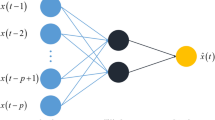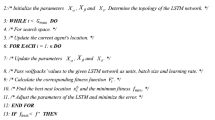Abstract
With rapid industrialization and urbanization, air pollution has become an increasingly severe problem. As a key indicator of air quality, accurate prediction of the air quality index (AQI) is essential for policymakers to establish effective early warning management mechanisms and adjust living plans. In this work, a hybrid multi-scale fusion prediction paradigm is proposed for the complex AQI time series prediction. First, an initial decomposition and integration of the original data is performed by combining the complete ensemble empirical mode decomposition with adaptive noise (CEEMDAN) and sample entropy (SE). Then, the subsequences, divided into high-frequency and low-frequency groups, are applied to different processing methods. Among them, the variational mode decomposition (VMD) is chosen to perform a secondary decomposition of the high-frequency sequence groups and integrated by using K-means clustering with sample entropy. Finally, multi-scale fusion training of sequence prediction results with different frequencies by using long short-term memory (LSTM) yields more accurate results with R2 of 0.9715, RMSE of 2.0327, MAE of 0.0154, and MAPE of 0.0488. Furthermore, validation of the AQI datasets acquired from four different cities demonstrates that the new paradigm is more robust and generalizable as compared to other baseline methods. Therefore, this model not only holds potential value in developing AQI prediction models but also serves as a valuable reference for future research on AQI control strategies.
Graphical Abstract














Similar content being viewed by others
Data availability
The data used in this paper is publicly available at the China National Environmental Monitoring Centre, http://www.cnemc.cn/sssj/.
References
Athira V, Geetha P, Vinayakumar R, Soman K (2018) Deepairnet: applying recurrent networks for air quality prediction. Procedia Comput Sci 132:1394–1403. https://doi.org/10.1016/j.procs.2018.05.06
Bai L, Liu Z, Wang JZ (2022) Novel hybrid extreme learning machine and multi-objective optimization algorithm for air pollution prediction. App Math Model 106:177–198. https://doi.org/10.1016/j.apm.2022.01.023
Bai N, Khazaei M, van Eeden SF, Laher I (2007) The pharmacology of particulate matter air pollution-induced cardiovascular dysfunction. Pharmacol Ther 113:16–29. https://doi.org/10.1016/j.pharmthera.2006.06.005
Bai Y, Li Y, Wang XX, Xie JJ, Li C (2016) Air pollutants concentrations forecasting using back propagation neural network based on wavelet decomposition with meteorological conditions. Atmos Pollut Res 7:557–566. https://doi.org/10.1016/j.apr.2016.01.004
Brunekreef B, Holgate ST (2002) Air pollution and health. Lancet 360:1233–1242. https://doi.org/10.1016/S0140-6736(02)11274-8
Calderón-Garcidueñas L, Solt AC, Henríquez-Roldán C, Torres-Jardón R, Nuse B, Herritt L, Villarreal-Calderón R, Osnaya N, Stone I, García R (2008) Long-term air pollution exposure is associated with neuroinflammation, an altered innate immune response, disruption of the blood-brain barrier, ultrafine particulate deposition, and accumulation of amyloid β-42 and α-synuclein in children and young adults. Toxicol Pathol 36:289–310. https://doi.org/10.1177/0192623307313011
Castelli M, Clemente FM, Popovič A, Silva S, Vanneschi L (2020) A machine learning approach to predict air quality in California. Complexity 2020:8049504. https://doi.org/10.1155/2020/8049504
Chen ZZ, Liu BQ, Yan XG, Yang HQ (2019) An improved signal processing approach based on analysis mode decomposition and empirical mode decomposition. Energies 12:3077. https://doi.org/10.3390/en12163077
Dong JW, Wang YH, Wang LL, Zhao WJ, Huang C (2022) Assessment of PM2. 5 exposure risk towards SDG indicator 11.6. 2–a case study in Beijing. Sustain Cities Soc 82:103864. https://doi.org/10.1016/j.scs.2022.103864
Dragomiretskiy K, Zosso D (2013) Variational mode decomposition. Trans Signal Process 62:531–544. https://doi.org/10.1109/TSP.2013.2288675
Fu ML, Le CW, Fan TC, Prakapovich R, Manko D, Dmytrenko O, Lande D, Shahid S, Yaseen ZM (2021) Integration of complete ensemble empirical mode decomposition with deep long short-term memory model for particulate matter concentration prediction. Environ Sci Pollut Res 28:64818–64829. https://doi.org/10.1007/s11356-021-15574-y
Gan K, Sun SL, Wang SY, Wei YJ (2018) A secondary-decomposition-ensemble learning paradigm for forecasting PM2. 5 concentration. Atmos Pollut Res 9:989–999. https://doi.org/10.1016/j.apr.2018.03.008
Hochreiter S, Schmidhuber J (1997) Long short-term memory. Neural Comput 9:1735–1780. https://doi.org/10.1162/neco.1997.9.8.1735
Huang NE, Shen Z, Long SR, Wu MC, Shih HH, Zheng QA, Yen N-C, Tung CC, Liu HH (1998) The empirical mode decomposition and the Hilbert spectrum for nonlinear and non-stationary time series analysis. Proc R Soc London Ser A 454:903–995. https://doi.org/10.1098/rspa.1998.0193
Ji CL, Zhang C, Hua L, Ma HX, Nazir MS, Peng T (2022) A multi-scale evolutionary deep learning model based on CEEMDAN, improved whale optimization algorithm, regularized extreme learning machine and LSTM for AQI prediction. Environ Res 215:114228. https://doi.org/10.1016/j.envres.2022.114228
Jiang P, Li C, Li RR, Yang HF (2019) An innovative hybrid air pollution early-warning system based on pollutants forecasting and Extenics evaluation. Knowl Based Syst 164:174–192. https://doi.org/10.1016/j.knosys.2018.10.036
Kulmala M (2015) Atmospheric chemistry: China’s choking cocktail. Nature 526:497–499. https://doi.org/10.1038/526497a
Li GH, Tang YZ, Yang H (2022a) A new hybrid prediction model of air quality index based on secondary decomposition and improved kernel extreme learning machine. Chemosphere 305:135348. https://doi.org/10.1016/j.chemosphere.2022.135348
Li HT, Jin F, Sun SL, Li YW (2021) A new secondary decomposition ensemble learning approach for carbon price forecasting. Knowl Based Syst 214:106686. https://doi.org/10.1016/j.knosys.2020.106686
Li YM, Peng T, Hua L, Ji CL, Ma HX, Nazir MS, Zhang C (2022b) Research and application of an evolutionary deep learning model based on improved grey wolf optimization algorithm and DBN-ELM for AQI prediction. Sustain Cities Soc 87:104209. https://doi.org/10.1016/j.scs.2022.104209
Liu H, Zhang XY (2021) AQI time series prediction based on a hybrid data decomposition and echo state networks. Environ Sci Pollut Res 28:51160–51182. https://doi.org/10.1007/s11356-021-14186-w/Published
Liu SC, Xing J, Wang SX, Ding D, Chen L, Hao JM (2020) Revealing the impacts of transboundary pollution on PM2. 5-related deaths in China. Environ Int 134:105323. https://doi.org/10.1016/j.envint.2019.105323
Ma J, Ding Y, Cheng JC, Jiang FF, Gan VJ, Xu ZR (2020) A Lag-FLSTM deep learning network based on Bayesian Optimization for multi-sequential-variant PM2. 5 prediction. Sustain Cities Soc 60:102237. https://doi.org/10.1016/j.scs.2020.102237
MacQueen J (1967) Classification and analysis of multivariate observations. Proceedings of the 5th Berkeley Symposium on Mathematical Statistics and Probability 281-297.
Pishgar M, Karim F, Majumdar S, Darabi H (2018) Pathological voice classification using mel-cepstrum vectors and support vector machine. arXiv preprint arXiv:1812.07729. https://doi.org/10.48550/arXiv.1812.07729
Richman JS, Moorman JR (2000) Physiological time-series analysis using approximate entropy and sample entropy. Am J Phys Heart Circ Phys 278:2039–2049. https://doi.org/10.1152/ajpheart.2000.278.6.H2039
Salman AG, Heryadi Y, Abdurahman E, Suparta W (2018) Single layer & multi-layer long short-term memory (LSTM) model with intermediate variables for weather forecasting. Procedia Comput Sci 135:89–98. https://doi.org/10.1016/j.procs.2018.08.153
Song C, Fu XS (2020) Research on different weight combination in air quality forecasting models. J Clean Prod 261:121169. https://doi.org/10.1016/j.jclepro.2020.121169
Song ZY, Tang C, Ji JK, Todo Y, Tang Z (2021) A simple dendritic neural network model-based approach for daily PM2. 5 concentration prediction. Electronics 10:373. https://doi.org/10.3390/electronics10040373
Sun JY, Zhao PP, Sun SL (2022) A new secondary decomposition-reconstruction-ensemble approach for crude oil price forecasting. Resour Policy 77:102762. https://doi.org/10.1016/j.resourpol.2022.102762
Torres ME, Colominas MA, Schlotthauer G, Flandrin P (2011) A complete ensemble empirical mode decomposition with adaptive noise. IEEE:4144–4147. https://doi.org/10.1109/ICASSP.2011.5947265
Tu LP, Chen Y (2021) An unequal adjacent grey forecasting air pollution urban model. App Math Model 99:260–275. https://doi.org/10.1016/j.apm.2021.06.025
Vlachogianni A, Kassomenos P, Karppinen A, Karakitsios S, Kukkonen J (2011) Evaluation of a multiple regression model for the forecasting of the concentrations of NOx and PM10 in Athens and Helsinki. Sci Total Environ 409:1559–1571. https://doi.org/10.1016/j.scitotenv.2010.12.040
Wang DY, Wei S, Luo HY, Yue CQ, Grunder O (2017) A novel hybrid model for air quality index forecasting based on two-phase decomposition technique and modified extreme learning machine. Sci Total Environ 580:719–733. https://doi.org/10.1016/j.scitotenv.2016.12.018
Wang JJ, Gao RX, Yan RQ (2014) Integration of EEMD and ICA for wind turbine gearbox diagnosis. Wind Energy 17:757–773. https://doi.org/10.1002/we.1653
Wang JZ, Li HM, Lu HY (2018) Application of a novel early warning system based on fuzzy time series in urban air quality forecasting in China. Appl Soft Comput 71:783–799. https://doi.org/10.1016/j.asoc.2018.07.030
Wang JZ, Li HM, Yang HF, Wang Y (2021) Intelligent multivariable air-quality forecasting system based on feature selection and modified evolving interval type-2 quantum fuzzy neural network. Environ Pollut 274:116429. https://doi.org/10.1016/j.envpol.2021.116429
Wu ZH, Huang NE (2009) Ensemble empirical mode decomposition: a noise-assisted data analysis method. Adv Adapt Data Anal 1:1–41. https://doi.org/10.1142/S1793536909000047
Xiang L, Li JX, Hu AJ, Zhang Y (2020) Deterministic and probabilistic multi-step forecasting for short-term wind speed based on secondary decomposition and a deep learning method. Energy Conver Manage 220:113098. https://doi.org/10.1016/j.enconman.2020.113098
Xu HH, Chen H (2021) Impact of urban morphology on the spatial and temporal distribution of PM2. 5 concentration: a numerical simulation with WRF/CMAQ model in Wuhan, China. J Environ Manage 290:112427. https://doi.org/10.1016/j.jenvman.2021.112427
Yan R, Liao JQ, Yang J, Sun W, Nong MY, Li FP (2021) Multi-hour and multi-site air quality index forecasting in Beijing using CNN, LSTM, CNN-LSTM, and spatiotemporal clustering. Expert Syst Appl 169:114513. https://doi.org/10.1016/j.eswa.2020.114513
Yue WM, Liu QR, Ruan YJ, Qian FY, Meng H (2022) A prediction approach with mode decomposition-recombination technique for short-term load forecasting. Sustain Cities Soc 85:104034. https://doi.org/10.1016/j.scs.2022.104034
Zhang C, Peng T, Nazir MS (2022) A novel hybrid approach based on variational heteroscedastic Gaussian process regression for multi-step ahead wind speed forecasting. Int J Electr Power Energy Syst 136:107717. https://doi.org/10.1016/j.ijepes.2021.107717
Zhao C, Wang Q, Ban J, Liu ZR, Zhang YY, Ma RM, Li SS, Li TT (2020) Estimating the daily PM2. 5 concentration in the Beijing-Tianjin-Hebei region using a random forest model with a 0.01× 0.01 spatial resolution. Environ Int 134:105297. https://doi.org/10.1016/j.envint.2019.105297
Zheng QH, Tian X, Yu Z, Jiang N, Elhanashi A, Saponara S, Yu R (2023) Application of wavelet-packet transform driven deep learning method in PM2.5 concentration prediction: a case study of Qingdao, China. Sustain Cities Soc 92:104486. https://doi.org/10.1016/j.scs.2023.104486
Zhou FT, Huang ZH, Zhang CH (2022) Carbon price forecasting based on CEEMDAN and LSTM. Appl Energy 311:118601. https://doi.org/10.1016/j.apenergy.2022.118601
Zhou JG, Wang SG (2021) A carbon price prediction model based on the secondary decomposition algorithm and influencing factors. Energies 14:1328. https://doi.org/10.3390/en14051328
Zhou WJ, Wu XL, Ding S, Cheng YK (2020) Predictive analysis of the air quality indicators in the Yangtze River Delta in China: an application of a novel seasonal grey model. Sci Total Environ 748:141428. https://doi.org/10.1016/j.scitotenv.2020.141428
Zhu SL, Lian XY, Liu HX, Hu JM, Wang YY, Che JX (2017) Daily air quality index forecasting with hybrid models: a case in China. Environ Pollut 231:1232–1244. https://doi.org/10.1016/j.envpol.2017.08.069
Acknowledgements
Thanks are due to Yufan Deng, Tianqi Xu and Zuoren Sun for their valuable discussion.
Funding
This research was supported by the National Natural Science Foundation of China, Grant No. 72074138; Shandong Social Science Planning Research Project, Grant No. 22CJJJ24; Humanities and Social Science Project of Shandong Province, Grant No. 2021-YYJJ-09; Young Scholars Program of Shandong University Weihai, and the National Social Science Foundation of China, Grant No. 21BGL304.
Author information
Authors and Affiliations
Contributions
Yufan Deng: software, validation, debugging, feasibility analysis, writing—original draft. Tianqi Xu: software, data curation, investigation, writing—original draft. Zuoren Sun: conceptualization, methodology, supervision, writing—review and editing.
Corresponding author
Ethics declarations
Competing interests
The authors declare no competing interests.
Additional information
Responsible Editor: Marcus Schulz
Publisher’s Note
Springer Nature remains neutral with regard to jurisdictional claims in published maps and institutional affiliations.
Rights and permissions
Springer Nature or its licensor (e.g. a society or other partner) holds exclusive rights to this article under a publishing agreement with the author(s) or other rightsholder(s); author self-archiving of the accepted manuscript version of this article is solely governed by the terms of such publishing agreement and applicable law.
About this article
Cite this article
Deng, Y., Xu, T. & Sun, Z. A hybrid multi-scale fusion paradigm for AQI prediction based on the secondary decomposition. Environ Sci Pollut Res (2024). https://doi.org/10.1007/s11356-024-33346-2
Received:
Accepted:
Published:
DOI: https://doi.org/10.1007/s11356-024-33346-2




